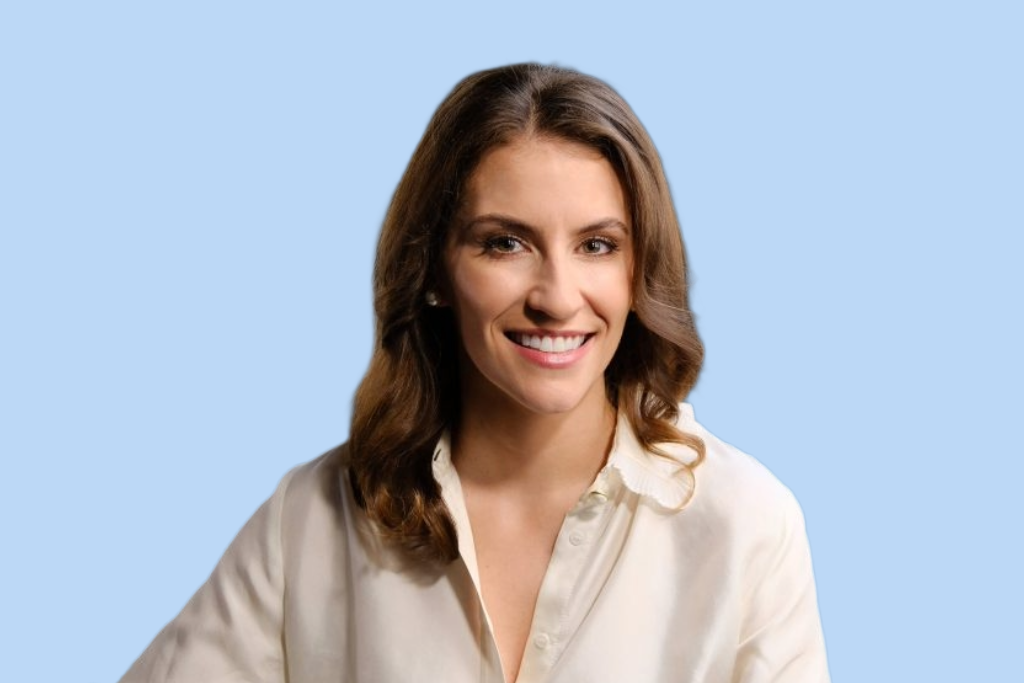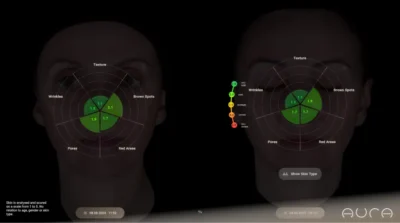By providing a detailed visual roadmap of treatment options, Aura’s 3D imaging system has been shown to increase patient confidence by 37% during consultations, leading to higher conversion rates and increased revenue for clinics.
One of the most powerful tools we can employ as aesthetic practitioners in an effective anti-ageing consultation is clear, visual communication. Aura’s 3D Imaging System has helped provide that, transforming how I consult, diagnose, plan, and educate my patients.
With my background in dentistry and orthodontics, as well as aesthetic medicine, I’ve always had a special interest in facial anatomy and symmetry. As a result, I’ve trialled countless imaging technologies over the years in the pursuit of a device that brings to life the nuances I see in a patient’s face – while helping my patients understand them too.
That’s what first drew me to Aura 3D Imaging, which I discovered at The Aesthetic and Anti-Aging Medicine World Congress in Monaco. It gives me something new for my consultations: fast, high-quality scans that make even the more subtle asymmetries and emerging skin concerns visible to patients. It’s not just a diagnostic tool either. It’s a powerful way to build trust with patients, while enhancing treatment planning and results. Here’s why it is now an indispensable addition to my aesthetic consultations:
It brings consultations to life
Consultations are a crucial step in any clinic. Designed right, they can build trust and explore all aspects of facial ageing, supporting a patient’s concerns and helping lead to more successful treatment bookings.
That’s why Aura now forms a core part of every anti-ageing consultation in my clinic. It is not just about documentation – it’s about diagnosis and dialogue. Aura’s 3D models of a patient’s face enable us to rotate, zoom, and analyse from multiple angles, identifying subtle asymmetries, volume loss, or other emerging skin concerns that may otherwise go unnoticed. That makes it easier to explain why a chin may appear off-balance, or how softening a muscle group could reshape the profile. This transparency isn’t just helpful – it’s transformative.
In one standout case, for example, I recently treated a woman with only botulinum toxin to the lower face. The result: a dramatic change in facial symmetry and chin contour that traditional photos would have missed, but Aura captured beautifully. That moment wasn’t just proof of efficacy; it validated both patient experience and practitioner skill.
It makes consultations collaborative
Aura isn’t just an invaluable diagnostic tool – it’s also pivotal for creating a collaborative consultation experience. Instead of having a patient stare uncomfortably into a mirror while pointing out imperfections, I review scans with them side-by-side, so we can review the 3D image together. This creates a more empowering dynamic with the patient no longer being talked at; they’re engaged participants who can view and understand the “why” behind our recommendations. Take, for example, a recent patient who came in with vague concerns about her cheeks – having read online about cheek pad separation. Aura allowed me to show her exactly what was happening, explaining the ageing process both scientifically and compassionately.
It makes consultations more comfortable
Aura has changed the tone of aesthetic consultations too. Unlike traditional before-and-after photos, which some find invasive or emotionally confronting, Aura scans are fast, hands-off, and user-friendly, while still capturing clinically beneficial results. Older patients and first timers find it particularly reassuring, because the process is intuitive and stress-free, offering a gentler introduction to what can be a vulnerable process.
At the same time, unlike static before-and-after photos, Aura doesn’t require perfect posture or head positioning – and uses standardised lighting, making it much more accessible. There’s one quick flash and no awkward, repeat positioning under a harsh light – eliminating the stress of trying to capture ‘the perfect shot’ for both patient and staff! Instead, patients are often pleasantly surprised by how smooth and respectful the scanning process feels.
It makes consultations clearer
Patients also rarely arrive with clear-cut treatment goals. Instead, they come in saying things like, “I feel like I look tired,” or “I just don’t recognise myself anymore.” These are complex emotional statements, not technical diagnoses. So, for years, doctors have had to rely on our own expertise alone to decode these concerns. Aura helps bridge this gap because it offers clear and objective 3D visuals that bring clarity to patient-practitioner discussions. Rather than debating opinions, we can return to the scan and discuss what’s actually happening – especially if a patient is unsure if a treatment has worked for them.
This depth of insight also helps patients feel genuinely “seen” and informed in consultations, and that understanding builds trust. I had a particularly memorable case with a patient who had lost a significant amount of weight. She felt her face had completely collapsed and was anxious about how to address it. She was reassured by Aura’s precise mapping, which allowed us to create a personalised treatment plan that addressed her specific concerns without overwhelming her.
Managing expectations
One of the most powerful applications of Aura in consultations is in managing expectations. People come into clinic with all sorts of information from social media, magazines, and countless online sources. They’ve heard about so many treatments and are often overwhelmed, confused, or have unrealistic expectations. Aura helps cut through the noise. Instead of showing them what someone else looks like in static imagery, we can focus entirely on their unique facial structure and concerns. Its visual clarity makes it easier to set realistic goals and reinforce the rationale behind each recommendation. The ability to zoom, rotate, and annotate scans in real-time allows me to demonstrate the “why” behind each recommendation.
It’s just as important for follow-up consultations too. With high-definition before-and-after scans, patients can see exactly where improvements have occurred – even when results are subtle. This reduces doubt, builds confidence, and reinforces long-term trust in both treatment and provider. In a crowded industry filled with marketing buzzwords and trends, Aura provides a science-based counterbalance, helping me guide patients back to what’s going on in their faces.
Long-term treatment planning
Aura also plays a key role in long-term treatment planning during consultations. After all, ageing is continuous, and while aesthetic treatments can restore balance and freshness, the process doesn’t just stop. Skin maintenance is like fitness – you need to work harder to maintain it as you age.
That’s why I break down ageing into three key targets during consultations: skin quality, muscle dynamics, and structural changes. Aura helps me illustrate each of these aspects beautifully. It’s like having a 3D map of facial ageing that patients can understand, so, it becomes easier to explain how different treatments can work, and how maintenance is just as important as transformation.
More specifically:
- Skin: Aura helps identify surface-level concerns like redness, textural changes, and early photodamage. This is useful for planning treatments, as these issues often respond well to lasers, injectables, or topicals.
- Muscle: Aura captures dynamic expressions and areas of tension – such as those that cause frown lines and jaw clenching, helping to pinpoint where treatments such as toxin injections should be placed.
- Structure: By clearly showing volume changes from different angles, patients can better understand why their face may appear “collapsed” with age or weight loss, and grasp why some treatments are more appropriate than others.
It is great for my team
The technology has helped change who can conduct aesthetic consultations in my clinic as well. As the technology is intuitive, and easily integrated, everyone in my team can perform scans independently, freeing my time to deliver more treatments, while eliminating inconsistencies in photography for properly documented before-and-after photos. In fact, the high-quality image you can get in seconds would have taken ages and required multiple bits of equipment, to do manually. That’s so important for clinics striving for high-end, evidence-based care.
Standardising Excellence
Looking to the future, I believe imaging technology like Aura will become the minimum standard required in aesthetic medicine. Just as we can’t imagine doing certain medical procedures without ultrasound, soon it will feel outdated to even think about changing someone’s appearance without a 3D model. And, as platforms like Aura continue to evolve, with even more predictive analytics and treatment simulations, that should be the standard we are all aiming for.
Ultimately, Aura has helped transform my consultations by building trust, supporting evidence-based treatment planning, and helping patients feel seen and understood. And, for me, that’s what great aesthetic medicine is all about. More than just treatments, it’s about helping people feel confident as they age. By bridging the gap between the emotional and clinical aspects of ageing, while creating a more transparent, collaborative approach, Aura has become an essential part of that mission during aesthetic consultations.
Dr Jennifer Owens is a cosmetic dentist and aesthetic injector with an MSC in Aesthetic Medicine. She runs The Glow Clinic in Dublin and Cork, Ireland.




